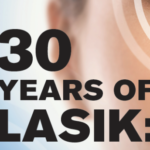In 1989, 30 years ago this year, the US Patent and Trademark Office awarded a patent for peforming LASIK to Gholam Peyman, MD. This patent represented nearly 100 years of evolution of eye surgery to correct vision. I had the opportunity to assist on the first case of LASIK in the Western United States, performed in 1992 by Charles Casebeer, MD, my fellowship mentor. Laser vision correction, in the form of PRK, was approved by the FDA for use in the United States in 1995. LASIK itself recieved formal FDA approval in 1999, 20 years ago. Since the time that patent was awarded 30 years ago, and 20 years since FDA approval, an estimated 40 million cases of LASIK have been performed worldwide with a success rate of 99.5%. Over the past 20 years, LASIK has undergone incredible evolution. In 2003, the FDA approved the next generation of LASIK, customized wavefront LASIK, which incorporated NASA-derived technology to measure the optics of the eye and customize the laser treatment to an individual’s unique optical characteristics. Since that time, there have been three generations of customized wavefront technology: original cusomized wavefront LASIK, ultra-high resolution customized wavefront LASIK, and ultra-high resolution customized wavefront LASIK using iris registration systems for targeting and alignement of the laser on the cornea. We also now have the ability to peform topography guided LASIK in which a map of the cornea is used to direct the laser beam. Today’s latest generation customized wavefront and topography guidedl LASIK technology are incredibly precise and results are significantly improved from the already impressive results we achieved 20 years ago. Today, the lastest version of LASIK truly represents one of the miracles of modern medicine.

